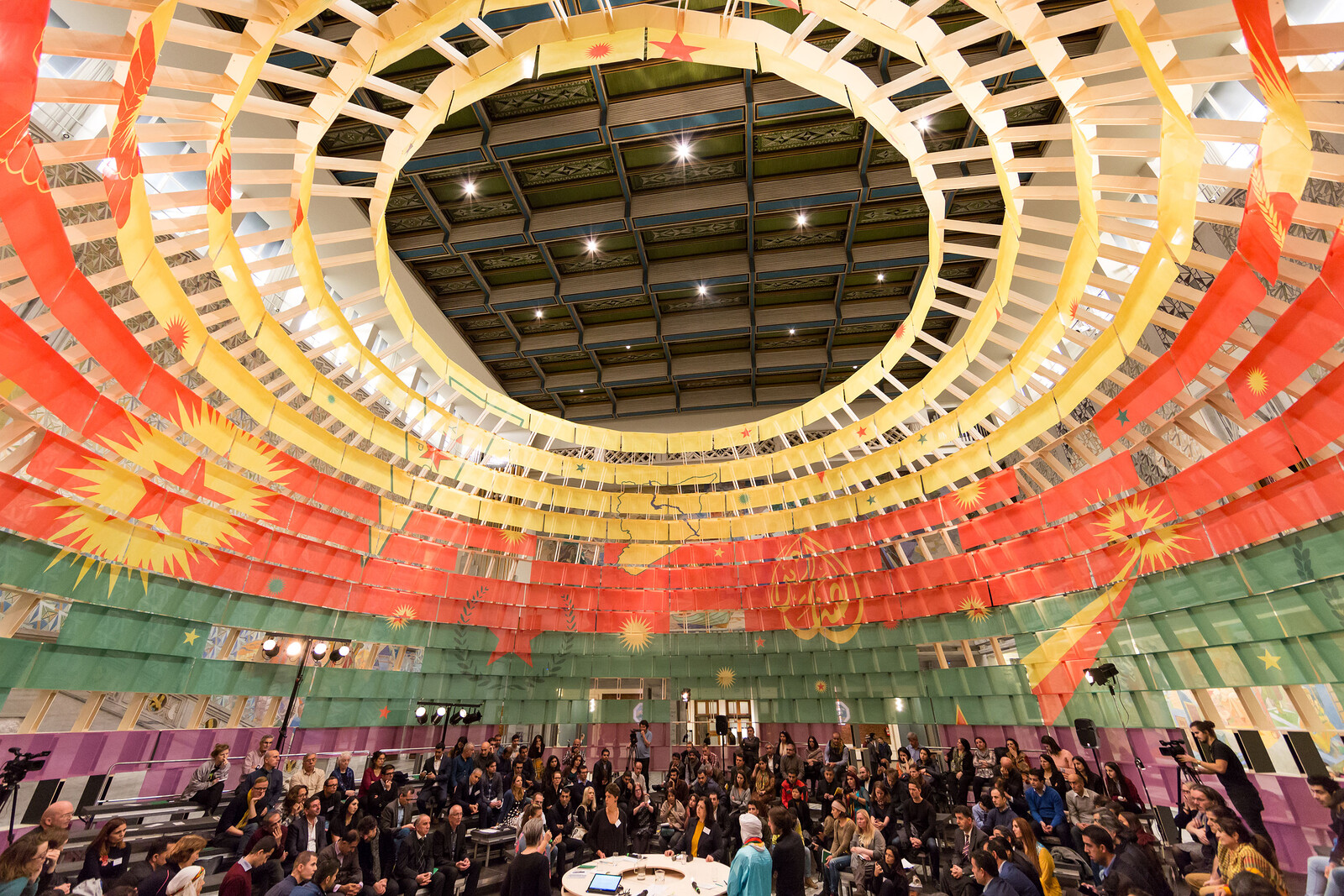New Authoritarian World Order
To build an effective resistance mobilized by a new collectivity, we must understand and change the lines of division imposed upon us by an authoritarian world order. Today, we are living under a growing, global network of extremist authoritarian regimes: from Trump in the United States to Temer in Brazil, from ultranationalists and fascists rising throughout Europe to Erdoğan in Turkey, and from Putin in Russia to Modi in India. This ultranationalist and patriarchal new world order aims to impose lines of division intended to defeat emancipatory politics indefinitely.1
I speak here specifically about the Us/Them dichotomy re-entrenched over the past fifteen years of the War on Terror.2 “Us” can be the self-proclaimed, enlightened liberal-democratic order (there’s not much liberal nor democratic about it) versus “Them”: the so-called terrorist, barbarian other. “Us” can be the white, American upper and middle classes re-enforcing their privilege against “Them”: people of color, immigrant communities, Muslims. “Us” can be the Brexit voters claiming their country back from “Them”: the Eurocratic elites and the so-called tsunami of refugees.3
The real, unnamed line of division is that between the precarious classes and the corporate-political elite: that is the true Us versus Them—the only division worth holding to.4 So how do we assemble a new definition of Us? And how do we locate the constituents that would define such a collectivity? These questions are explored in Judith Butler’s Towards a Theory of Performative Assembly (2015). Not just a reflection on how performative assembly generates the embodiment of a new collectivity, this book allows us to articulate a practice of performative assembly—a practice that links the domains of art, theater, performance, activism, and politics, which I propose to name assemblism.


At Vladimir Putin’s annual news conference in Moscow in December 2016, a journalist holds up a poster with the portraits of Putin (left), France’s far-right National Front leader Marine Le Pen (center), and US president-elect Donald Trump. Photo: AP.
Towards a Practice of Performative Assembly
The aim of Butler’s Towards a Theory of Performative Assembly is to theorize models of public assembly that emerged within worldwide social movements in the first fifteen years of the twenty-first century: from the manifold movements stretching from Tunis to Egypt and Syria known as the “Arab Spring,” to the emergence of the M15/Los Indignados movement in Spain, Catalonia, and the Basque Country, to the worldwide Occupy movement, the Indignant Citizens Movement in Greece, the Gezi Park protests in Turkey, the Umbrella Movement in Hong Kong, Black Lives Matter, Nuit Debout in France, and Standing Rock—as well as assemblies in the form of collective hunger strikes in military prisons such as Guantánamo Bay, demonstrations by undocumented migrants and refugees, university occupations by students, and even online mobilizations to massively petition or hack into certain regimes.5
In other words, Butler observes a geographically, politically, and culturally diverse set of peoples and groups that all, one way or another, assemble. Their bodies gather at a specific place, or coordinate a series of similar, and most importantly simultaneous, gestures in different places. In both cases, they enact a political choreography that suggests the articulation of some form of collectivity.
The first question is why certain bodies assemble in ways that become meaningful as a potential collectivity capable of opposing the Us/Them dichotomy. Butler opts for the rubric of precarity, arguing that this term describes the results of the massive neoliberal privatization of common infrastructures; precarity, she writes, “brings together women, queers, transgender people, the poor, the differently abled, and the stateless, but also religious and racial minorities.”6 Clearly, the conditions of precarity in these examples differ radically: a student demanding a reduction of their debt by joining the collective occupation of a university building represents a different condition of precarity than a prisoner in Guantánamo Bay who decides to join a collective hunger strike. But although conditions of precarity differ, in all cases the term denotes the falling away of a necessary collective infrastructure of life support. Thus, Butler argues that precarity can operate “as a site of alliance among groups of people who do not otherwise find much in common and between whom there is sometimes even suspicion and antagonism.”7 In other words, the precariat—the precarious classes, the proletariat of the twenty-first century—could be a potential class-in-the-making through which a variety of peoples could become aligned.8
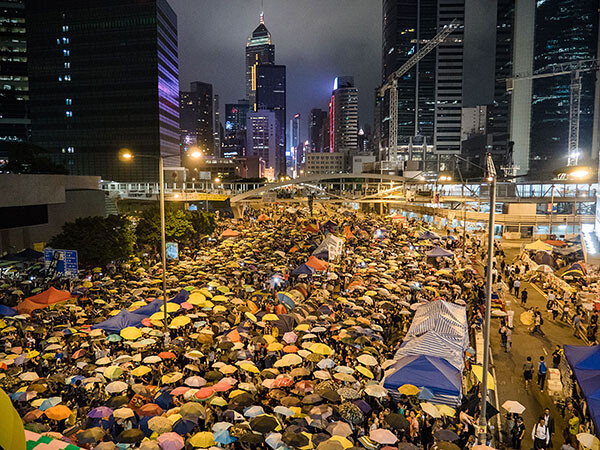

The Umbrella Movement in Hong Kong, on its thirty-first day of protest and occupation, 2014. Photo: Pasu Au Yeung.
The first step in understanding the process in which the precariat articulates a new collectivity is to see the body as the foundation of the social architecture that we call “assembly.” Butler here emphasizes the importance of understanding the body not as an isolated entity: “We cannot talk about a body without knowing what supports that body, and what its relation to that support—or lack of support—might be,” because “the body is less an entity than a living set of relations; the body cannot be fully dissociated from the infrastructural and environmental conditions of its living and acting.”9 This means that the collective gathering of bodies in the form of an assembly is an inherent act of resistance against the lack of care that a given regime provides to these bodies. When masses of people lose their houses due to a criminal mortgage system and assemble with their tents in a park, then this assembly is a response to a dysfunctional or absent collective infrastructure. The assembly is simultaneously a direct expression of the condition of precarity and a protest against it.
But when the precariat gathers its bodies in the form of an assembly, it also gains the potential to propose alternatives to the regimes that have forced it into this assembly in the first place. This is what Butler describes as the performative dimension that defines the social form of the public assembly10 (and which I propose as the practice of assemblism):
A social movement is itself a social form, and when a social movement calls for a new way of life, a form of liveable life, then it must, at that moment, enact the very principles it seeks to realize. This means that when it works, there is a performative enactment of radical democracy in such movement that alone can articulate what it might mean to lead a good life in the sense of a liveable life.11
Although social movements and their public assemblies are often critiqued for their lack of clear demands, there is—if we follow Butler—a propositional or even prefigurative dimension to the performative process in which the precariat gathers and generates its social forms.12 To make this very concrete: in Occupy Amsterdam, where I resided with about thirty fellow artists, the coalition of students, civil organizations, activists, homeless people, etc., organized a common kitchen and food distribution center, a free library, a tent for medical treatment, and a space for the daily general assembly through which the camp governed itself.13 In the case of the New University student occupation in Amsterdam, a similar set of alternative institutions were devised in the process of assembling its constituents: students programmed their own curricula, inviting philosophers and theorists to give free lectures to students and nonstudents alike; they set up a general assembly for the daily self-governance of the university; they organized a parallel University of Colour14; and they built coalitions with We Are Here, a collective of undocumented migrants and refugees, as well as with the cleaners union of the Netherlands.15
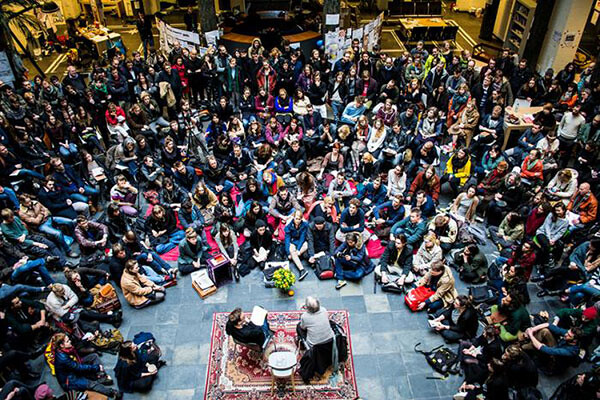

Jacques Rancière lectures in the public program of the New University occupation of Amsterdam, 2015. Photo: Nicola Zolin.
While neither of these two assemblies proposed anything like a ten-point political program, they most certainly did perform an agenda by articulating and devising a new set of institutions: a new social form that provided “life support,” making a different Us—a new collectivity—possible. As Butler writes, “In the most ideal instances, an alliance begins to enact the social order it seeks to bring about by establishing its own modes of sociability.”16 The social order that emerges from the practice of assemblism remains fragile, precarious—occupations of streets and squares tend to come and go, as do their general assemblies, temporary libraries, and food distribution centers—but it nonetheless embodies and enacts what Butler calls new “infrastructure and architecture” that “take part in the making of the space of politics.”17
The process in which the precariat assembles and performs its new social forms is at constant risk of being romanticized. The assembly in the square is often presented as the moment in which the capital-P “People” appear unmediated in some kind of evental rupture, a “genuine” democracy embodied in the famous slogan of the alterglobalization movement: “This is what democracy looks like!” There is a risk in focusing on the assembly as a solution, rather than as a forced moment of public exposure in which the precariat assembles due to a material threat to its system of life support. Romanticization can negate that which we might learn and win through the assembly, if we could build its social forms into a new type of institutionality altogether.18 Once the squares are empty again, this new institutionality needs to be formalized, organized, and enacted under administrative structures of checks and balances that guarantee durable physical and economic security and fidelity to the collectivity that brought it into being in the first place.19
It is also important to remember that there is always an unchosen element in the practice of assembly. There has never been some kind of democratic magic at play when the precariat has revolted against one tyrant or another. There is nothing necessarily desirable about building common ground within the radically diverse and internally conflicting precariat. To put it simply: we never unambiguously choose to assemble. We assemble because our capacity for self-determination is in some way violated, or even because we have no other choice left. Nor do we choose with whom we assemble. Assemblism is the practice of the unchosen:
Whoever “we” are, we are also those who were never chosen, who emerge on this earth without everyone’s consent, and who belong, from the start, to a wider population and a sustainable earth. And this condition, paradoxically, yields the radical potential for new modes of sociality and politics beyond the avid and wretched bonds formed through settler colonialism and expulsion. We are all, in this sense, the unchosen, but we are nevertheless unchosen together.20
The Art of Assemblism
While the practice of performative assembly cannot and should not be understood in purely artistic terms, Butler references terminology that emphasizes the role that art plays within the political practice of assemblism. For example, she discusses the assembly as “assemblage,” and also speaks of the “theatrical” dimension of the assembly and the “morphology” of its social forms.21 “Morphology” here is a term from biology that refers to knowledge gained through the visual observation of form, the intersection of forms, and the mutation of form.
In the process of trying to understand the artistic dimension of assemblism, let us begin with a simple observation: there is always a relation between power and form. There is a performative aspect to power, a process through which power enacts itself and which results in specific morphological constructs. This is what Edward S. Herman and Noam Chomsky famously defined as the workings of propaganda. The creation of monopolies of power through intersecting domains of politics, economy, and media results in a construction—a performance—of a normative reality.22 This process creates what Joseph Masco describes as a “feedback loop”: monopolies of power perform a normative reality that benefits these same monopolies of power.23 But just as constructions of power differ, so do forms of propaganda—resulting in different, often conflicting propagandas.24 Whereas political and corporate elites keep populations in check by projecting upon them the imminent threat of terrorism or biological warfare, emerging powers such as the social movements that Butler discusses have the capacity to project a completely different claim to collective power, one based on notions like democratization, transparency, wealth redistribution, and so on.25 Radically different than the powers of the expanded state that emerged through the War on Terror, the performance of the emerging powers of the precariat points toward a form of emancipatory propaganda.26
In sum, whereas political and economic elites construct realities that normalize and strengthen the power of ruling minorities, social movements like those discussed by Butler propagate a collective power of precarious majorities that form a direct threat to the status quo. This collective power generates a morphology (the social form emerging through the practice of assemblism—one could call it a “propaganda”) structured—composed, scripted, choreographed—by egalitarian ideals. An example is prisoners engaged in a collective hunger strike. Even though each prisoner is in their own cell, their simultaneous choreography reaffirms that no matter how much the prison divides them physically, they continue to enact a script—a series of planned gestures—in collectivity. A different morphology of collectivity is performed in the case of bodies that have the relative privilege of gathering in public, for example in a general assembly, the daily circle of self-governance present in social movements such as Los Indignados, Occupy, and Nuit Debout. The form of the circle is literally shaped by the bodies of the participants in the assembly, resulting in an architecture of collective power that cannot exist if the collective is not literally present at that very moment. If the bodies disperse, the Parliament of Bodies ceases to exist.27
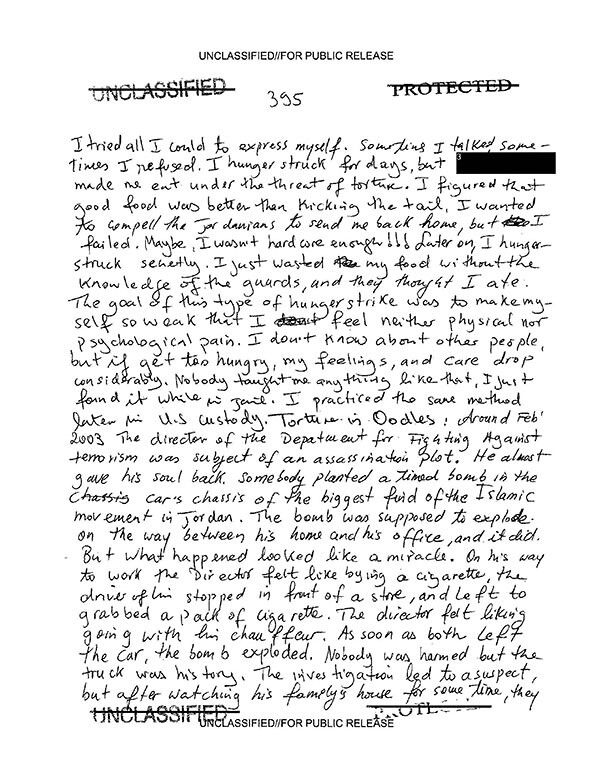

Redacted page from Guantánamo Diary (2015) by Mohamedou Ould Slahi, who was imprisoned in Guantánamo Bay from 2002 to 2016. In this part of the text he describes his involvement in individual and collected hunger strikes with other inmates at the prison. Written in 2005, the manuscript would not be declassified for publication until 2012.
Most important in the way these two examples of assemblism perform collectivity is the imaginary that they evoke—the surplus of presence they bring into being. Encountering one prisoner in a hunger strike while knowing others are performing similar gestures reinforces the idea of an unlimited number of people standing with a single individual. The synchronicity of the gestures in this form of assemblism generates the sense of a larger collectivity. Something similar happens in the circular assembly in the square: when the people who are present refer to themselves as the “99 percent” or something similar, they perform as if they were a majority, even though they are factually a minority. In this way, assemblism lays the foundation for a collectivity yet to emerge. A new Us is performed as if it is already a majority, before it manifests materially.
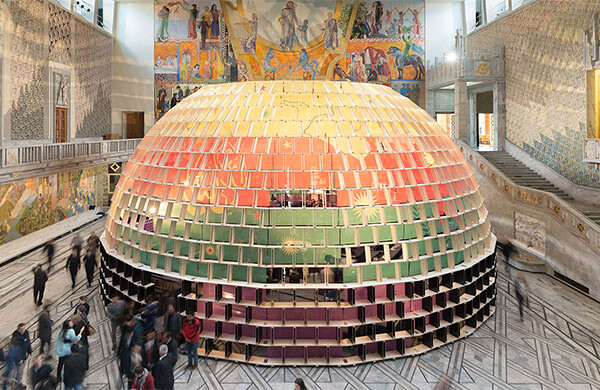

Exterior view of the New World Embassy: Rojava (2016), coproduced by Oslo Architecture Triennial: After Belonging & URO/KORO, Democratic Self-Administration of Rojava, and Studio Jonas Staal. Photo: István Virág.
Although the morphology of these assemblies tends to be described as “spontaneous,” they are not accidental. The very form of the square, for example, tends to structure the conditions for assemblism through containment: severely limiting the amount of bodies that can be present. Similarly, the dispersed assembly of the hunger strike is structured through the specific conditions of prison architecture. This, we could say, also names the paradox of the morphology of assemblism, as the claim to a new power is articulated through the infrastructure of the regime it struggles against. I have witnessed this myself on several occasions, ranging from Occupy Amsterdam, which had to shape itself within the rather tiny square of Beursplein, to the revolutionary Rojava government in northern Syria, which has had to organize its alternative model of stateless assembly-based democracy within the rigid, modernist, hierarchical architectural structures left by the Assad regime.28
I have worked alongside many colleagues and friends in a variety of political movements, organizations, and platforms. As artists in assemblism—as assemblists—we have learned how the emerging power of collectivity generates new morphologies. In other words, we have observed and attempted to practice the artistic within the performance of the political. As such, we have learned about the mathematics of egalitarianism: a gathering of two hundred and fifty people can make some of those people feel alienated and excluded within the staging of a collectivity. We have learned that the form of the circle can be inclusive, but it can also be exclusive; sometimes, differential privileges develop between the “inner circle” of people who have been there from the beginning, and the “outer circle” of people who joined at a later stage.29 We have learned that using chairs maintains the liberal order that emphasizes the sovereign individual above the collective, whereas benches maintain the principle of negotiating and sharing collective space. We have learned that using digital projections can turn a gathering of people into a gathering of observers rather than a gathering of potential actors.30 These are questions that relate to the morphology of assemblism and the visual literacy needed to translate its prefigurative propositions of alternative institutionality into truly new and durable morphologies of transdemocracy.31
As artists, we are not in power, but through morphology we give power: we give form to power. The practice of assemblism that we can derive from Butler’s work opens up the possibility of a new collectivity arising from the precariat—a new Us with the potential to shatter the Us/Them divide that has brought the new authoritarian world order into being. Embedding our artistic practice within social movements, we can help formulate the new campaigns, the new symbols, and the popular poetry needed to bolster the emergence of a radical collective imaginary. In that process, we can also begin to devise the new infrastructures—the parallel parliaments,32 the stateless embassies, the transdemocratic unions—needed to establish the institutions that will make a new emancipatory governance a reality.
Our time as assemblists is now. As the tsunami of authoritarian decrees from Trump to Erdoğan suggests, our time might never come again.
As Maria Hlavajova notes in her introduction to the appropriately titled book Former West: “The country that routinely calls itself the leader of the free world has just blatantly shown that bigotry, xenophobia, misogyny, racism, climate change denial, etc., are at the core of how it wants to be governed. All this to loud jubilation of right-wing ideologues in the west and across the globe, saluting the birth of a new world order, once again.” Former West: Art and the Contemporary after 1989, eds. Maria Hlavajova and Simon Sheikh (Cambridge, MA: MIT Press, 2017), 15.
In the work of Brian Michael Goss, for example, the Us/Them dichotomy is discussed as the dominant ideological doctrine of the War on Terror. Reviving the trope of orientalism, Goss argues, allowed Saddam Hussein and his regime to become constructed as “exotic, traditional, sensuous, mysterious” while simultaneously being framed as “brutal, untouched by the rigors of reason, subjected to the primitive social organization of the leader and the led.” Against this, George W. Bush could be contrasted as the enlightened crusader of Western democracy. Goss goes on to comment that “the paired exaltation and denigration of Our and Their leaders perhaps mutually summon each other into being.” Brian Michael Goss, Rebooting the Herman & Chomsky Propaganda Model in the Twenty-First Century (New York: Peter Lang Publishing, 2013), 98, 104.
This political use of the term “tsunami”—equating migration and fleeing refugees with the devastation caused by natural disaster (or rather, climate change)—was first coined by Geert Wilders, leader of the Dutch Freedom Party, when he described the “tsunami of Islamization” as the greatest threat to the Netherlands and the West at large. See Sanne ten Hoove and Raoul du Pré, “Wilders bang van ‘tsunami van islamisering,’” Volkskrant, October 6, 2006 →.
Sven Lütticken rightfully points out that this division entails far more than income inequality, as was demonstrated by the Brexit vote, in which well-off citizens who owned houses tended to vote “leave,” while people in more precarious conditions and those with mortgages tended to vote “remain.” The Us/Them divide is as much political and cultural as it is economic. See Sven Lütticken, “Who Makes the Nazis?,” e-flux journal 76 (October 2016) →.
Not all these examples are examined in Butler’s book, partly because Black Lives Matter and Standing Rock had not yet emerged when she was writing it. But a different category of assemly that seems missing from the book is heavily politicized online assemblies that aim at collective action, for example in the form of transnationally organized “DDoS” attacks (Distributed Denial of Service)—essentially a tactic to overwhelm websites by accelerating their data usage. Although DDoS attacks are also used by governments in cyber offensives and are certainly not exclusive to progressive groups, historic cases such as Operation Payback (2010), which took down the websites of Visa and Mastercard in retaliation for their refusal to accept donations to WikiLeaks, are examples of forms of transnational assembly with a potential to construct diverse collectivities. See Esther Addley and Josh Halliday, “WikiLeaks supporters disrupt Visa and Mastercard Sites in ‘Operation Payback,’” The Guardian, December 9, 2010 →.
Judith Butler, Notes Towards a Performative Theory of Assembly (Cambridge, MA: Harvard University Press, 2015), 58.
Ibid., 27.
See Guy Standing, The Precariat: The New Dangerous Class (London: Bloomsbury Academic, 2011).
Butler, Notes Towards a Performative Theory of Assembly, 65.
In a collaborative book project with Athena Athanasiou, Butler writes in a crucial passage that “the performative emerges precisely as the specific power of the precarious—unauthorized by existing legal regimes, abandoned by the law itself—to demand the end of precarity.” Judith Butler and Athena Athanasiou, Dispossession: The Performative in the Political (Cambridge: Polity Press, 2013), 121.
Butler, Notes Towards a Performative Theory of Assembly, 218.
Butler’s own speech at the Occupy Wall Street protests in Zuccotti Park, New York on October 23, 2011 can be considered a marking point for her theory on performativity and the enactment of new social forms. She said: “As bodies we suffer, we require shelter and food, and as bodies we require one another and desire one another. So this is a politics of the public body, the requirements of the body, its movement and voice. We would not be here if elected officials were representing the popular will. We stand apart from the electoral process and its complicities with exploitation. We sit and stand and move and speak, as we can, as the popular will, the one that electoral democracy has forgotten and abandoned. But we are here, and remain here, enacting the phrase, ‘we the people.’” See →.
For accounts from different members of Artists in Occupy Amsterdam, see Actors, Agents and Attendants: Social Housing—Housing the Social: Art, Property and Spatial Justice, eds. Fulya Erdemci and Andrea Phillips (Berlin: Sternberg Press, 2012).
The University of Colour emerged as a critique of and alternative to what its initiators considered the underlying colonial and white bias of the demands and knowledges propagated by the New University. The University of Colour, in contrast, sought to “decolonize the university.” See →.
On the role of art in instituting the New University, see Jonas Staal, “New Art for the New University,” June 15, 2015 →.
Butler, Notes Towards a Performative Theory of Assembly, 84.
Ibid., 127.
Not An Alternative argues for a form of “institutional liberation,” meaning that through social movements, occupations, boycotts, etc., existing institutions can become repurposed within the imaginary of an alternative institutionality brought forward by the precariat: “Institutional liberation isn’t about making institutions better, more inclusive, more participatory. It’s about establishing politicized base camps from which ever more coordinated, elaborate, and effective campaigns against the capitalist state in all its racist, exploitative, extractivist, and colonizing dimensions can be carried out. This takeover will not happen overnight. But it is happening now at an international scale, accumulating force and momentum with every repetition of a common name and image, every iteration of associated acts: red lines, red squares, arrayed tents, money drops, blockades, occupations.” Not An Alternative, “Institutional Liberation,” e-flux journal 77 (November 2016) →.
Jodi Dean’s work on the concept of the “crowd” overlaps in some respects with the assemblies of the precariat discussed by Butler. However, Dean takes a more militant approach in arguing that the egalitarian potential of the crowd must be translated through a new international Communist Party. Through the Community Party, she writes, the crowd can emerge as the People. See Dean’s lecture “If You’re Not Against Us, You’re With Us,” Former West Public Editorial Meeting, Hungary, May 13, 2015 →. See also Dean, Crowds and Party (Brooklyn: Verso, 2016).
Butler, Notes Towards a Performative Theory of Assembly, 116.
Ibid., 68, 85, 87. Regarding art and morphology, see also Jonas Staal, “Ideology = Form,” e-flux journal 69 (January 2016) →. The notion of “assemblage” here resonates with Yates McKee’s history of art within the Occupy Movement and its aftermath: “Like the camp itself that would be set up in the following month, the founding assembly might be understood as a kind of embodied collage, transposing an alien political form into both the ossified landscape of the New York Left and the symbolic heart of global capital itself.” Yates McKee, Strike Art: Contemporary Art and the Post-Occupy Condition (Brooklyn: Verso, 2016), 93. Hito Steyerl, in the context of the alterglobalization movement, speaks similarly of its “montage.” Hito Steyerl, The Wretched of the Screen (Berlin: Sternberg Press, 2012), 78.
Herman and Chomsky, who articulated their famous “propaganda model” in the late Eighties, identified five “filters” through which monopolies of power come to perform normative reality: ownership, advertising, information dependency, flak (distortion), and anticommunism. They also proposed a form of counter-propaganda (what I will call “emancipatory propaganda”) realized through the “organization and self-education of groups in the community and workplace, and their networking and activism.” Noam Chomsky and Edward S. Herman, Manufacturing Consent (New York: Pantheon Books, 1988), 307.
Masco speaks of the expanded concept of biosecurity in the War on Terror, which “promises a world without terror via the constant production of terror,” and as such ends up creating “a potentially endless recursive loop of threat production and response.” Joseph Masco, The Theater of Operations (Durham, NC: Duke University Press, 2014), 156.
The idea that propaganda should be understood in the plural is taken from the philosopher Jacques Ellul, whose “Propaganda: The Formation of Men’s Attitudes” (1962) is a rather curious translation of the original plural French title: “Propagandas.”
The notion of emerging power resonates with what Gerald Raunig, following Emmanuel Joseph Sieyès and Antonio Negri, describes as “constituent power”: a “collective subjectivation, instituation, and formation beyond constituted power.” Raunig writes that constituent power is the driving force of “micropolitical” practices through which an alternative, non-statist history of art can be articulated. Gerald Raunig, Art and Revolution: Transversal Activism in the Long Twentieth Century (Los Angeles: Semiotext(e), 2007), 54, 60. In the case of assemblism, we will speak of “emerging power,” since the cases examined by Butler are so radically differentiated.
In her essay “Some Propaganda for Propaganda” (1984), Lucy Lippard spoke of emancipatory propaganda as an “inherently feminist … more intimate” form of propaganda. See Lucy Lippard, To the Third Power: Feminism, Art, and Class Consciousness (New York: Dutton, 1984), 117.
“Parliament of Bodies” is the title of the Athens edition of documenta 14. It attempts to broaden Bruno Latour’s concepts of the “Parliament of Things.” See Iliana Fokianaki, “Missing Bodies,” Frieze, October 24, 2016 →.
This has been discussed by the founders of Decolonizing Architecture Art Residency, who note that “throughout the histories of decolonization, the possibility of reusing existing structures in the very same ways they were used under colonial regimes has proven too tempting to resist.” However, they simultaneously emphasize that “colonial remnants and ruins are not only the dead matter of past power, but could be thought of as material for re-appropriations and strategic activation within the politics of the present.” The latter certainly applies to the autonomous Rojava region. See Alessandro Petti, Sandi Hilal, and Eyal Weizman, Architecture After Revolution (Berlin: Sternberg Press, 2013), 20, 21.
Jo Freeman’s “The Tyranny of Structurelessness” (1970) makes a similar point. In the context of the Women’s Movement, she observed that “the members of a friendship group will relate more to each other than to other people. They listen more attentively, and interrupt less; they repeat each other’s points and give in amiably; they tend to ignore or grapple with the ‘outs,’ whose approval is not necessary for making a decision. But it is necessary for the ‘outs’ to stay on good terms with the ‘ins.’” See →.
Although I agree with Claire Bishop that the “binary of active/passive” tends to be reductive, the practice of assemblism certainly does aim to shift agency amongst participants, although this is admittedly more complex than switching from a politics of representation to one of “presence.” From a Butlerian perspective we could very well argue that our bodily presence is also a form of mediation and representation. In the context of assemblism, the term “actor” is closer to what Augusto Boal termed “spect-actor.” See Claire Bishop, Artificial Hells (London: Verso, 2012), 38.
See Jonas Staal, “Transdemocracy,” e-flux journal 76 (October 2016) →.
Decolonizing Architecture Art Residency points to Palestine’s history of a parliament-in-exile—born out of devastating colonial violence—as a model of extraterritorial “Common Assembly,” which survives state violence through time “precisely because their gatherings have no fixed seats.” Petti, Hilal, and Weizman, Architecture After Revolution, 169.
Category
Subject
This text resulted from a lecture presented at the conference Solution Communism, organized by Iliana Fokianaki, Ingo Niermann, and Joshua Simon on January 21, 2017 at State of Concept, Athens. The text will be further elaborated for the conference Resonances of the Work of Judith Butler on April 5–7 at the Vrije Universiteit, Amsterdam. I would like to thank Vincent W. J. van Gerven Oei, Iliana Fokianaki, and Brian Kuan Wood for their support in writing this essay.
